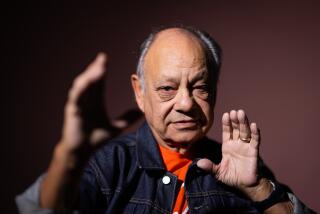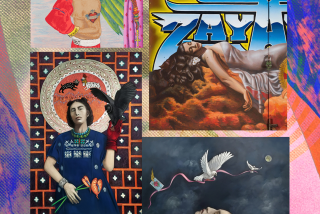Touring Retrospective Examines Chicano Art
For some, the Chicano movement came and went. For others it is alive and gaining strength. But one of its enduring manifestations are the artworks, from pencil drawings to murals, which arose from the late 1960s to mid-1970s and beyond.
“Chicano Art: Resistance and Affirmation, 1965-1985” (CARA) will chronicle the movement through art in its premiere exhibition at UCLA’s Wight Art Gallery from Sept. 9 through Dec. 9.
Chicanos such as Luis Jimenez, Mel Casas, Judith F. Baca, Carmen Lomas-Garza and John Valadez will be among the 90 artists featured in the exhibit, along with group installations showcasing pieces by ASCO, Los Four and The Royal Chicano Air Force.
The exhibit, held in conjunction with the Los Angeles Festival, is one of the largest assemblages ever of Chicano artworks, with 130 paintings, drawings, posters, sculptures, photographs and murals.
“(CARA) will prove to be an informational, educational tool so that people understand that Chicano art is a viable and very strong force within American art--that is, the United States and Latin America,” said Teresa McKenna, CARA executive committee member and a professor of English at USC.
Chicano art is CARA’s focus because “Hispanic usually refers to a conglomeration of Hispanic cultures, Cuban, Puerto Rican, and other Hispanic cultures,” said CARA assistant publicist Lindsey Haley.
“Latino also carries that kind of large connotation, whereas Chicano is a term that was developed during the Chicano movement to reflect the political attitude of affirmation,” Haley said.
Organizers of the $1-million project met with 50 artists, authors and Chicano activists in 1985 to form the “Chicano Art: Resistance and Affirmation” theme.
“It’s a process of self-definition. We tried to give artists and members of the Chicano community a chance to define who they are,” said Wight Gallery curator Elizabeth Shepherd.
The CARA theme “has to do with the history of the Southwest, and the notion of resistance and affirmation has to do with culture, as well as politics. It has to do with the affirmation of one’s culture in the face of political change,” McKenna said.
“Chicano art is not that different from the so-called mainstream,” according to Margarita Nieto, a professor of Chicano Studies at Cal State Northridge who has written on art for the past 14 years. “It has a bite to it, an aggressiveness . . . a vitality that comes from this confrontation, living on-the-edge feeling that is much a part of the aesthetics of contemporary art.”
Exhibits will be divided into sections including the pre-movement; la causa: farm workers; cultural icons; civil liberties; urban images; regional expressions; Chicana feminist visions, and redefining American art.
A sampling of more than 40 murals from throughout the country will be shown in a large-scale slide presentation along with a videotape to show each mural in its social and geographical context.
On Sept. 9, a special program, “Dia Para Los Angeles,” will be held from noon to 5 p.m. The free activities will include speakers, music, dance, children’s theater and bilingual tours of the exhibition.
After the three-month stay in Los Angeles, CARA will travel to Denver, Albuquerque, Tucson, San Francisco, Fresno, Washington, Madrid and Mexico City over the next three years.
Admission to the Wight Art Gallery exhibit is free. Open Tuesdays 11 a.m. to 8 p.m. and Wednesdays through Sundays 11 a.m. to 6 p.m. Closed Mondays and holidays. Docent tours will be conducted in English and Spanish. Parking ($4) via UCLA entrance at 405 Hilgard Ave.; (213) 825-9345.
More to Read
The biggest entertainment stories
Get our big stories about Hollywood, film, television, music, arts, culture and more right in your inbox as soon as they publish.
You may occasionally receive promotional content from the Los Angeles Times.










